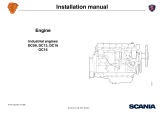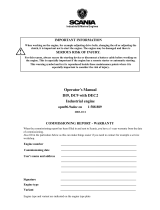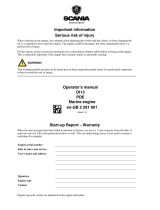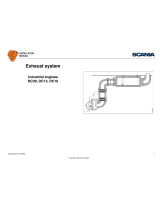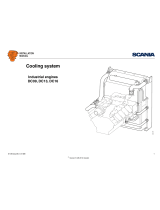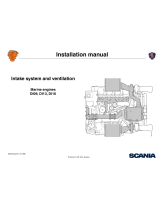Page is loading ...

01:01 Issue 9.0 en-GB
© Scania CV AB 2018, Sweden
Installation manual
Engine
Industrial engines
DC09, DC13, DC16
OC16
333 291

INSTALLATION
MANUAL
© Scania CV AB 2018, Sweden
01:01 Issue 9.0 en-GB 2
Changes from the previous issue............................................................................ 3
Engine suspension....................................................................................................4
Suspension design requirements ......................................................................... 4
Rigid engine suspension...................................................................................... 5
Flexible engine suspension.................................................................................. 5
Tightening torque for engine suspension ............................................................ 8
Permissible installation and operating angles ..................................................... 9
Flywheel housing .............................................................................................. 10
Generator set dynamics ..................................................................................... 12
Lifting the engine .............................................................................................. 13
Accessibility for maintenance and repairs ..........................................................16
Installation requirements ................................................................................... 16
Clearances ......................................................................................................... 17
Engine alignment...................................................................................................18
Aligning engine and shafts................................................................................ 19
Power transmission ...............................................................................................24
Flexible coupling............................................................................................... 24
Friction clutch ................................................................................................... 25
Transmission types ................................................................................................26
Mechanical transmissions ................................................................................. 26
Belt transmissions ............................................................................................. 26
Power take-off........................................................................................................ 28
Front-mounted power take-offs......................................................................... 29
Side-mounted power take-offs .......................................................................... 32
Calculation example for torque take-off from power take-off.......................... 39
Air compressor...................................................................................................... 40
Torsional oscillations ............................................................................................ 41
Data for torsional oscillation calculation.......................................................... 41
Torsional oscillation calculations from Scania................................................. 42
General tightening torques for screw joints ....................................................... 43
Specification of normal tightening torques....................................................... 43
Tightening torques ............................................................................................ 44
Sticker “Powered by Scania”............................................................................... 47

INSTALLATION
MANUAL
© Scania CV AB 2018, Sweden
Changes from the previous issue
01:01 Issue 9.0 en-GB 3
Changes from the previous issue
The changes made in this document compared with the previous issue are marked
with a black line in the left-hand margin. The changes are also described below.
• Section Suspension design requirements
has been made clearer.
• In section Insulators
, maximum and minimum loads and dimensions for Scania
insulators have been added.
• In section Tightening torque for engine suspension
, a tightening sequence for the
engine brackets has been added.
• Section Calculation example for bending torque on flywheel housing
has been
added.
• Working procedures for Lifting the engine
have been added.
• Clearances for Downward facing centrifugal oil cleaner
have been added.
• Section Flexible coupling
has been made clearer.
• In section Power take-off
, a text and illustration has been added, informing the
reader that components from other manufacturers cannot be used in the belt trans-
mission.
• Hydraulic diagram for hydraulic pump
has been added.
• Calculation example for torque take-off from power take-off
has been added.
• In section Data for torsional oscillation calculation
, information has been added
on what values Scania needs in order to approve an external torsional oscillation
calculation.

INSTALLATION
MANUAL
© Scania CV AB 2018, Sweden
Engine suspension
01:01 Issue 9.0 en-GB 4
Engine suspension
Suspension design requirements
The type of engine suspension that is appropriate varies for different engine installa-
tions. In general, the following applies:
• The engine suspension should be designed for the forces it is exposed to, both
continuously and momentarily during operation. Such forces are reaction forces
from the transmitted torque and in some cases longitudinal acceleration, retarda-
tion and reaction forces in the engine.
• Both the engine suspension and the engine bed should be designed so that there
are no resonant oscillations within the engine speed range. They should also be
designed so that annoying vibrations from the engine are not transmitted to the
surroundings.
• The suspension should be as rigid as possible. Use all 4 screw holes in the cylinder
block and flywheel housing for the respective engine bracket. See illustration.
• The engine bed location and the engine suspension must be designed so that the
permissible angles of inclination for the engine are not exceeded. See Permissible
installation and operating angles.
• The engine suspension and engine bed should be designed in a way which allows
access for maintenance and repairs.
There are two standard engine suspension designs:
• Rigid engine suspension
• Flexible engine suspension
393 928

INSTALLATION
MANUAL
© Scania CV AB 2018, Sweden
Engine suspension
01:01 Issue 9.0 en-GB 5
Rigid engine suspension
A rigid engine suspension can absorb greater forces in all directions than flexible en-
gine suspension. It requires highly accurate alignment of the engine in relation to the
driven unit. On the other hand, it requires no special flexibility in the hoses, pipes and
controls connected to the engine.
A rigid engine suspension can be used in engine installations where vibration causes
no significant problems and where other characteristics make it desirable.
Even with a rigid engine suspension, the transmission of vibration to the engine bed
can be kept low if the masses of the engine bed and connected parts are large in re-
lation to the mass of the engine.
It is also possible to construct flexible engine suspension between the frame and the
engine bed to reduce the transmission of vibration to the engine bed.
Flexible engine suspension
Flexible engine suspension dampens vibrations more effectively than rigid engine
suspension. Flexible engine suspension does not require such careful alignment of
the engine as rigid engine suspension. However, flexible engine suspension does not
absorb longitudinal and lateral forces in the engine to the same extent as rigid engine
suspension.
344 281
Examples of rigid engine suspension.
334 280
Examples of flexible engine suspension.

INSTALLATION
MANUAL
© Scania CV AB 2018, Sweden
Engine suspension
01:01 Issue 9.0 en-GB 6
Insulators
Cushyfloat insulators with hardness 55 or 65 Shore can be ordered as option. The fol-
lowing applies for these parts:
• The engine bracket and frame or engine bed should be parallel.
• The vertical centre lines should coincide laterally.
• The upper and lower parts of the insulators should be parallel longitudinally.
Tightening torque. Hardness marking.
max 1°
396 084
0
396 085
5
5
0°
396 086
310 404
160±10 Nm
310 405
55
55
alt. 65

INSTALLATION
MANUAL
© Scania CV AB 2018, Sweden
Engine suspension
01:01 Issue 9.0 en-GB 7
The illustration shows the dimensions of the insulators.
Vertical load, kg 55 Shore for DC09, DC13
Min. Max.
150 250
Vertical load, kg 65 Shore for DC16, OC16
Min. Max.
300 500
182
228
A
26
18
18
34
M20
394 808
Insulators 55 Shore for DC09 and DC13.
Dimension A: Without load = 70 mm. With load = 66 mm.
140
185
67
15
27
126
A
99
Ø
1
5
M
2
0
394 807
Insulators 65 Shore for DC16 and OC16.
Dimension A: Without load = 91 mm. With load = 86 mm.

INSTALLATION
MANUAL
© Scania CV AB 2018, Sweden
Engine suspension
01:01 Issue 9.0 en-GB 8
Tightening torque for engine suspension
The engine brackets can look different on different engine types, but all types of en-
gine bracket are tightened crosswise.
1. Torque tighten screws 1 and 2.
2. Torque tighten screws 3 and 4.
3. Angle-tighten screws 1 and 2.
4. Angle-tighten screws 3 and 4.
Front engine suspension
Rear engine suspension
Type of screw Tightening torques
25 mm clamping length, M16, 10.9 130 Nm, 90°
50 mm clamping length, M16, 10.9 130 Nm, 135°
Type of screw Tightening torques
M14, 8.8 149 Nm
1
3
4
2
394 815
Example of engine bracket.

INSTALLATION
MANUAL
© Scania CV AB 2018, Sweden
Engine suspension
01:01 Issue 9.0 en-GB 9
Permissible installation and operating angles
IMPORTANT!
If the angles of inclination are exceeded, lubrication system performance will deteri-
orate, which can cause damage to the engine or reduce its service life.
Maximum installation angle means maximum permissible installation angle for an
engine relative to the horizontal plane. The angle indicates the limit for engine incli-
nation during continuous operation.
Maximum operating angle means maximum permissible angle of inclination for an
engine in operation and with minimum oil level. The angle may only be used for
short periods. The maximum forward or rearward operating angles are not applicable
to their full extent if the engine is inclined laterally at the same time.
Engine type Type of oil sump Max. installation angle Max. operating angle Oil capacity (litres)
Inclination rear-
wards and for-
wards
Inclination lat-
erally
Inclination rear-
wards and for-
wards
Inclination lat-
erally
Min. Max.
DC09 Deep front without ladder frame 12° 12° 30° 30° 31 36
DC09 Low 12° 12° 25° 30° 28 35
DC13 Deep front without ladder frame 12° 12° 30° 30° 30 36
DC13 Deep front with ladder frame 12° 12° 30° 30° 39 45
DC13 Low 12° 12° 25° 30° 28 34
DC13 With deep centre part 12° 12° 35° 45° 33 39
DC16, OC16 Deep front without ladder frame 12° 10° 25° 30° 40 48
DC16 Low 12° 10° 25° 30° 29 37

INSTALLATION
MANUAL
© Scania CV AB 2018, Sweden
Engine suspension
01:01 Issue 9.0 en-GB 10
Flywheel housing
Silumin housings are supplied as standard on all industrial engines. The maximum
permissible bending torque for a silumin housing is 10,000 Nm. This presumes that
there are no axial loads from, for example, the propeller shaft, abnormal G forces or
vibration.
For certain engine types, it is also possible to select a nodular iron flywheel housing.
Nodular iron housings can dampen vibrations at certain engine speeds but increase
vibrations at other engine speeds. Nodular iron is stronger than silumin and can there-
fore tolerate greater bending and torsional forces.
The stronger nodular iron housings are recommended in installations where transport
causes serious stress on the flywheel housing, such as in dumper type trucks or gen-
erator sets with high outputs.
If it is difficult to determine the size and nature of the load, contact your nearest Sca-
nia distributor.

INSTALLATION
MANUAL
© Scania CV AB 2018, Sweden
Engine suspension
01:01 Issue 9.0 en-GB 11
Calculation example for bending torque on flywheel housing
Below is an example with 2 sets, A and B, which are attached to the flywheel hous-
ing. Set A has a mass of 170 kg and set B has a mass of 150 kg.
M
A
: Bending torque in Nm is calculated at the level of the flywheel housing.
F: Force in N, where 1 kg ≈ 10 N.
L
A
and L
B
: Distance in metres from the level of the flywheel housing to the mass
centre of set A and B.
The bending torque is calculated using the formula:
MA = FALA + FBLB
The values in the table above provide the following:
MA ≈ 1,700 x 0.233 + 1,500 x 0.65
MA ≈ 1,371 Nm
Set A Set B
Mass 170 kg 150 kg
Force F
A
= 1,700 N F
B
= 1,500 N
Distance L
A
= 0.223 m L
B
= 0.65 m
377 153
L
B
L
A
F
A
F
B
M
A
AB

INSTALLATION
MANUAL
© Scania CV AB 2018, Sweden
Engine suspension
01:01 Issue 9.0 en-GB 12
Generator set dynamics
If vibration levels in a generator set are too high, it could be due to resonance. This
may be because resonant frequencies of the receiving system are the same as the fre-
quency of the torque and disrupting power pulses that arise during normal operation
of combustion engines with a crankshaft. The resonant frequencies of the system de-
pend in turn on the mass and rigidity of component parts.
It is the responsibility of the installer to check that no resonant frequencies or vibra-
tion levels that could damage component parts are found anywhere in the engine in-
stallation.
The measurement and evaluation of vibrations in static parts is described in interna-
tional standards. See ISO 8528-9.
5
4
3
2
1
6
6
344 282
Example of generator set.
1. Engine.
2. Flywheel housing.
3. Adapter.
4. Generator.

INSTALLATION
MANUAL
© Scania CV AB 2018, Sweden
Engine suspension
01:01 Issue 9.0 en-GB 13
Lifting the engine
DC09 and DC13
WARNING!
The engine lifting eyes are dimensioned for lifting the engine only, not the engine to-
gether with connected equipment (e.g. alternator, gearbox) or frame. All 3 lifting
eyes must be used.
The lifting eyes are sized to cope with a maximum angle of 30°.
Too l
Number Designation Illustration
98 094 Lifting chain
587 308 Ratchet lever hoist
99 637 Lifting eye
1
4
2
0
3
3
142 730
319 634
max 30°
394 809

INSTALLATION
MANUAL
© Scania CV AB 2018, Sweden
Engine suspension
01:01 Issue 9.0 en-GB 14
1. Fit the lifting eyes in the flywheel housing.
2. Fasten the lifting chain to the rear lifting eyes.
3. Fasten the ratchet lever hoist to the front lifting eye.
4. Lift the engine, position it on the engine brackets and screw it into place.
DC16 and OC16
Too l
Number Designation Illustration
99 611 Lifting accessory
99 063 Lifting accessory
394 811

INSTALLATION
MANUAL
© Scania CV AB 2018, Sweden
Engine suspension
01:01 Issue 9.0 en-GB 15
WARNING!
The engine lifting eyes are dimensioned for lifting the engine only, not the engine to-
gether with connected equipment (e.g. alternator, gearbox) or frame.
The lifting eyes are sized to cope with a maximum angle of 30°.
1. Fit lifting accessory 99 611 on the flywheel housing (2).
2. Fit lifting accessory 99 063 in the front lifting eye (1) and in lifting accessory
99 611 (2).
3. Lift the engine, position it on the engine brackets and screw it into place.
max 30°
394 809
1
2
394 813

INSTALLATION
MANUAL
© Scania CV AB 2018, Sweden
Accessibility for maintenance and repairs
01:01 Issue 9.0 en-GB 16
Accessibility for maintenance and repairs
Installation requirements
The installer is responsible for ensuring accessibility for maintenance and repairs.
Note:
There must be sufficient space at installation so that standard times for maintenance
and repairs can be attained.
The following requirements for accessibility must be met:
• Canopies and connected components must be designed so that the engine can be
removed and fitted relatively easily.
• In the case of static engine installations, there should be permanent securing
points for lifting devices above the unit.
• The fuel system must be easily accessible for maintenance and bleeding.
• It should be possible to read the graduations on the flywheel when adjusting
valves and unit injectors.
• It should be possible to remove and fit the cylinder head, rocker covers and push-
rods while leaving the engine in place.
• It must be possible to remove the oil sump in order to renew cylinder liners or pis-
tons with the engine in place.
• It should be easy to fill and drain oil. In addition, the oil dipstick must be easily
accessible.
• Centrifugal oil cleaners and oil filters must be easy to access for maintenance and
for renewal.
• It should be easy to fill and drain coolant.
• Engine air filters must be located so that they are easy to access for the renewal
of filter elements.
It must also be easy to carry out maintenance on the following components:
• Turbocharger
• Starter motor
• Generator
• Coolant pump
•Radiator
• Cooling fan
• Flexible coupling or friction clutch
• Batteries
• Crankcase ventilation filter
For gas engines, it must also be easy to carry out maintenance on the following com-
ponents:
• Spark plug
• Flame arrestor
• Gas mixer insert
• Electric throttles
• Gas regulator
• Lambda sensor

INSTALLATION
MANUAL
© Scania CV AB 2018, Sweden
Accessibility for maintenance and repairs
01:01 Issue 9.0 en-GB 17
Clearances
The most important clearances are shown in the table and illustrations. The specified
measurements apply to the largest standard equipment.
Meas
ure-
ment
Clearance in mm For maintenance or renewal of
DC09 DC13 DC16 OC16
A 150 150 150 380 cylinder liner, cylinder head, etc.
B 250 260 260 260 oil sump
1
1. If the oil sump has a special design, these values do not apply.
F 400 400 400 500 various units
F
B
F
A
F
344 285
Clearances for DC09 and DC13.
F
A
A
B
F
F
F
344 286
Clearances for DC16 and OC16.

INSTALLATION
MANUAL
© Scania CV AB 2018, Sweden
Engine alignment
01:01 Issue 9.0 en-GB 18
Downward facing centrifugal oil cleaner
For engines with a downward facing centrifugal oil cleaner, the clearances in the il-
lustration apply.
Engine alignment
The alignment of the engine in relation to the driven unit is very important in order
to prevent malfunctions. Otherwise there is a risk of vibration and serious stress to
the crankshaft, engine brackets, drive shaft and flexible coupling or friction clutch,
causing damage which is costly to repair.
Alignment should be checked regularly on certain vibration-sensitive engine instal-
lations. Adjust engine alignment with shims between the engine bed and the engine
suspension.
The alignment requirements are reduced if a flexible coupling is installed between
the engine and the driven unit. Refer to the data on the flexible coupling concerned
for permissible deviations.
Relatively large deviations are permissible with flexible couplings. However, align-
ment should be as accurate as possible to achieve low vibration and a long service
life on the flexible coupling.
For more information, see Flexible coupling
.
240
160
394 028

INSTALLATION
MANUAL
© Scania CV AB 2018, Sweden
Engine alignment
01:01 Issue 9.0 en-GB 19
Aligning engine and shafts
Start from the driven shaft when aligning. First check that this is straight. Alignment
is made easier if the engine brackets are equipped with adjusting screws for vertical
and lateral adjustment. However, permanent setting should be made using shims.
Adjust the engine alignment vertically using shims between the engine bed and en-
gine suspension and laterally by moving the engine sideways on the surface. Shafts
with flanges: Start by aligning roughly and secure the engine to its engine bed. Mate
the flanges (1) so that the guide edge of one flange enters the guide hole of the other
flange.
Calculation of angular deviation
1. Fit the stand for the dial gauge (2) to the driving flange.
2. Align the tip of the dial gauge with the axial surface of the other flange as far as
possible.
3. Zero the dial gauge at 12 o'clock.
4. Place one of the retaining screws through both flanges without tightening it.
5. Turn the shafts at the same time and read the dial gauge at intervals of 90° while
turning one revolution. Enter the values in the table. Make sure you use the right
signs.
6. Calculate the angular deviation between the shafts using the values.
Location of measurement point Measurement value
1
1. + means inwards and - means outwards
12 o'clock ±0 mm
3 o'clock ± mm
6 o'clock ± mm
9 o'clock ± mm
2
1
344 283
Measuring angular deviation.

INSTALLATION
MANUAL
© Scania CV AB 2018, Sweden
Engine alignment
01:01 Issue 9.0 en-GB 20
Calculating thickness of required shims
Note:
Make sure you use the right signs in the calculations.
• If t is positive, shims should be added to the front or removed from the rear.
• If t is negative, shims should be added to the rear or removed from the front.
t = thickness of required shims.
L = distance between engine suspensions.
D = diameter of the flange where the dial gauge is mounted.
t =
6 o'clock
x L
D
/
